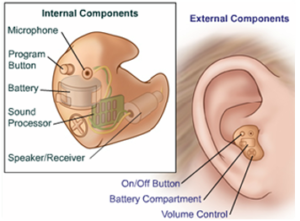Hearing loss can affect more than just your ability to follow conversations; it can impact your relationships, your safety, and your overall quality of life. The good news is that today’s hearing aids are more advanced, discreet, and effective than ever. But with so many styles and options available, it’s easy to feel overwhelmed.
At Florida E.N.T. & Allergy, we’re here to simplify the process. Whether you’re exploring hearing aids for the first time or looking to upgrade, understanding the different types of hearing aids and how they work can help you make a more confident, informed decision.

How Do Hearing Aids Work?
Although hearing aids come in different sizes and styles, most share the same essential components, each playing a vital role in helping you hear more clearly.

Internal Components (Inside the Device):
- Microphone: Picks up sounds from the environment and sends them to the processor.
- Sound Processor: Converts sounds into digital signals and adjusts them based on your hearing needs.
- Battery: Powers the device (can be disposable or rechargeable).
- Speaker/Receiver: Sends the processed sound into your ear.
- Program Button: Allows you to switch between listening modes (quiet room vs. noisy setting).
External Components (What You See and Use):
- On/Off Button: Powers the hearing aid on and off for daily use.
- Battery Compartment: Houses the battery and may also act as the on/off switch in some models.
- Volume Control: Lets you adjust sound levels manually (though many modern hearing aids auto-adjust).
Each of these parts is designed to work together to make hearing easier and more natural, helping you stay connected to the sounds and voices that matter most.
Common Types of Hearing Aids
The right hearing aid depends on your hearing loss, ear shape, lifestyle, and personal preferences. Here’s an overview of the most common types available today:

1. Invisible in the Canal (IIC)
- Placed deep inside the ear canal
- Virtually invisible when worn
- Suitable for mild to moderate hearing loss
- Smallest and most discreet option
- May have fewer features due to size limitations
- Wearers with dexterity issues may find it difficult to insert and remove
2. Completely in the Canal (CIC)
- Fits entirely inside the ear canal
- Slightly more visible than IIC but still discreet
- Great for mild to moderate hearing loss
- May have fewer features due to size limitations
- Wearers with dexterity issues may find it difficult to insert and remove
3. In the Canal (ITC)
- Sits in the lower portion of the outer ear canal
- Larger than CIC, allowing for more features
- Suitable for mild to moderate hearing loss
- May be easier to insert and remove than IIC and CIC
4. Receiver in Canal (RIC)
- Speaker (receiver) sits in the ear canal, while the main body rests behind the ear
- Connected by a thin wire
- Great sound quality and typically very comfortable
- Suitable for most degrees of hearing loss
- Often includes advanced features like Bluetooth and rechargeable batteries
5. Open Ear (Open Fit)
- A variation of RIC hearing aids
- Keeps the ear canal open to allow natural sound in alongside amplified sound
- Ideal for high-frequency hearing loss
- Lightweight and comfortable, with less “plugged” sensation
6. Behind the Ear (BTE)
- All components sit behind the ear, with a tube connecting to a custom earmold
- Suitable for mild to profound hearing loss
- Durable and often easier to handle
- Offers the most powerful amplification
- Can accommodate advanced features and larger batteries
7. High-powered Hearing Aids
- Typically BTE style
- Designed specifically for individuals with severe to profound hearing loss
- Provides the strongest amplification available
- Often recommended when traditional models no longer provide adequate support
Signs You Might Need a Hearing Aid
Hearing loss often happens gradually, and many people don’t recognize the signs right away. You may benefit from a hearing aid if you’ve experienced any of the following:
- Frequently asking others to repeat themselves
- Struggling to hear in noisy places (restaurants, group settings)
- Turning up the TV or radio to uncomfortable levels for others
- Missing parts of conversations or mishearing words
- Feeling fatigued or frustrated after social interactions
- Loved ones commenting on your hearing
- Difficulty hearing on the phone
Even mild hearing loss can affect your daily communication and cognitive health. If any of these sound familiar, it’s a good idea to schedule a hearing evaluation.
What to Expect from a Hearing Evaluation
At Florida E.N.T. & Allergy, our hearing evaluations are thorough and tailored to your needs. We’ll start with a conversation about your symptoms and medical history, followed by a series of safe, noninvasive tests to assess your hearing levels. If hearing loss is confirmed, we’ll walk you through your options and help you find the hearing aid that fits your lifestyle, budget, and preferences.
We also offer fittings, adjustments, and ongoing support to make sure your hearing aids are comfortable and performing their best.
Take the First Step Toward Better Hearing
You don’t have to navigate hearing loss alone. If you’re ready to hear more clearly, reconnect with loved ones, and feel more confident in daily conversations, our experienced team is here to help.
Schedule your hearing evaluation with Florida E.N.T. & Allergy today and explore your options for personalized, high-quality hearing care. We’ll help you find the hearing aid that’s right for you and support you every step of the way.

